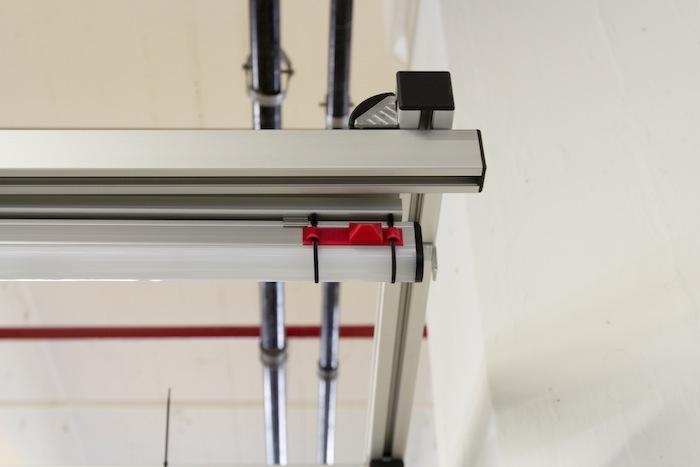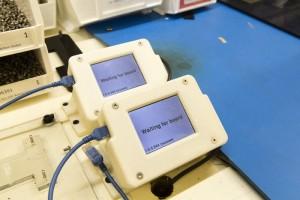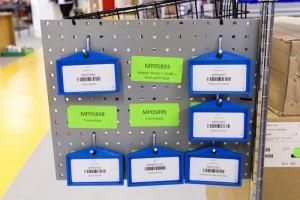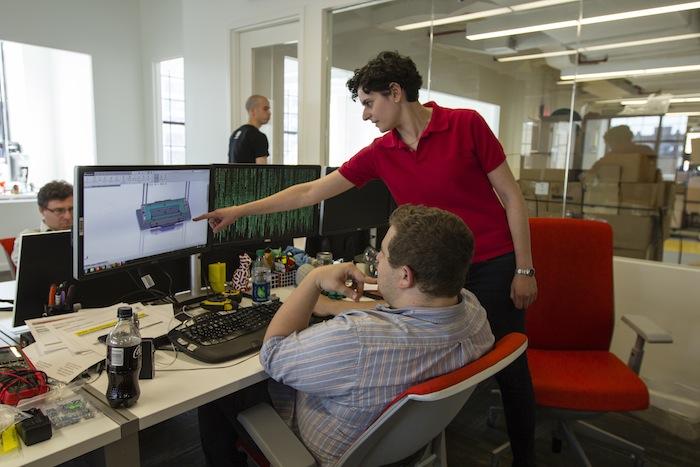They always say that a contractor’s house is never repaired and a cobbler’s kids have holes in their shoes. MakerBot has taken a step to make sure that 3D printer companies don’t earn the same reputation by turning their design and production skills to the creation of a better working environment for themselves. After new lights were installed over the workstations in the section of the factory where the MakerBot Replicator Z18 is made, the workers kept turning them off because they weren’t used to them.
 Better lighting has been consistently demonstrated to improve worker safety and productivity and Scott Hraska, a manufacturing engineer at the Brooklyn factory, knew that once the workers got used to it, it would be better for everyone. So, Hraska worked with an intern to create a rectangular cap to cover the light switch. The piece is held in place by zip ties fastening it to the frame of the workstation. It was a blinding flash of the obvious.
Better lighting has been consistently demonstrated to improve worker safety and productivity and Scott Hraska, a manufacturing engineer at the Brooklyn factory, knew that once the workers got used to it, it would be better for everyone. So, Hraska worked with an intern to create a rectangular cap to cover the light switch. The piece is held in place by zip ties fastening it to the frame of the workstation. It was a blinding flash of the obvious.
“That’s all it does,” Hraska remarked. “But that’s something you can’t buy – and it works really well.”
That’s exactly what 3D printing is so often called on to do: create obvious solutions to simple design problems – to take them from the ‘I wish we could just’ to the ‘how do we do the next thing?’
Using their own 3D design and production capabilities has helped not only to address the idiosyncratic needs of its particular factory, but also to continue to drive innovation and push production. Rather than spending their time in tedious meetings trying to justify a $10,000 expense (what the custom light fixtures would have cost had they not devised the zip-tie light switch cover) they can work up an idea, test it, and spend a couple of dollars in filament.
 Production facilities require all kinds of specialized equipment and there’s no reason why MakerBot should not take advantage of its own resources. Rather than spending $500 on tablets, manufacturing process engineer Sydney Dahl designed housings for a Raspberry Pi and provided the company with custom computers.
Production facilities require all kinds of specialized equipment and there’s no reason why MakerBot should not take advantage of its own resources. Rather than spending $500 on tablets, manufacturing process engineer Sydney Dahl designed housings for a Raspberry Pi and provided the company with custom computers.
Diana Pincus, MakerBot’s plant manager ,detailed an example of the savings:
“To set up production lines for the fifth generation of MakerBot Replicator 3D printers, creating jigs and fixtures on earlier models saved hundreds of thousands of dollars. Without the Replicator 2 and 2X, we’d still have been able to start the line, but it would have been more costly, less efficient, and a lot more stress.”
 Imagine a work environment in which employee suggestions and requests were as directly able to be turned into solutions. It creates not only happier employees, but encourages innovation and both of those things are key ingredients to the company’s success. Hraska demonstrated the depth of makers’ commitment to tinkering:
Imagine a work environment in which employee suggestions and requests were as directly able to be turned into solutions. It creates not only happier employees, but encourages innovation and both of those things are key ingredients to the company’s success. Hraska demonstrated the depth of makers’ commitment to tinkering:
“Once I realized I could make things, the biggest limitation was the size of the printer. And now we have the Z18.”
It looks like there are big things in the future for the MakerBot workplace.
What do you think of these initiatives over at MakerBot? Discuss in the 3D Printed Accessories at MakerBot forum thread at 3DPB.com.
Subscribe to Our Email Newsletter
Stay up-to-date on all the latest news from the 3D printing industry and receive information and offers from third party vendors.
You May Also Like
Supply Chain Management and the Role of 3D Printing Digital Inventories
As the additive manufacturing (AM) industry grows beyond its humble roots as a rapid prototyping technology, it has been adopted by some of the world’s leading companies to produce not...
3D Printing Webinar and Event Roundup: April 28, 2024
In this week’s 3D Printing Webinar and Event Roundup, the Ceramics Expo is taking place in Michigan, Stratasys continues its advanced training courses, and SPE is holding a Polymer Characterization...
$25M to Back Sintavia’s Largest Expansion of Metal 3D Printing Capacity Since 2019
Sintavia, the digital manufacturing company specializing in mission-critical parts for strategic sectors, announced a $25 million investment to increase its production capacity, the largest expansion to its operations since 2019....
Velo3D Initiates Public Offering in a Bid to Strengthen Financial Foundations and Drive Future Growth
Velo3D (NYSE: VLD) has been among a number of publicly traded 3D printing firms that have attempted to weather the current macroeconomic climate. After posting a challenging financial report for 2023,...
































